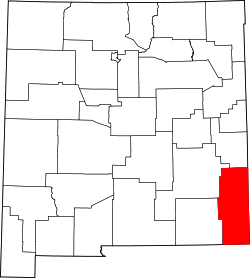Hobbs, New Mexico | |
|---|---|
City | |
| Motto: "It All Happens Here" | |
 Location of Hobbs, New Mexico | |
| Coordinates: 32°43′41″N103°09′36″W / 32.72806°N 103.16000°W [1] | |
| Country | United States |
| State | New Mexico |
| County | Lea |
| Government | |
| • Mayor | Sam Cobb |
| • City Manager | Manny Gomez |
| Area | |
• Total | 26.44 sq mi (68.47 km2) |
| • Land | 26.41 sq mi (68.39 km2) |
| • Water | 0.035 sq mi (0.09 km2) |
| Elevation | 3,642 ft (1,110 m) |
| Population | |
• Total | 40,508 |
| • Density | 1,534.2/sq mi (592.35/km2) |
| Time zone | Mountain (MST) |
| • Summer (DST) | UTC−6 (MDT) |
| ZIP codes | 88240-88242 |
| Area code | 575 |
| FIPS code | 35-32520 |
| GNIS feature ID | 2410771 [1] |
| Website | www |
Hobbs is a city in Lea County, New Mexico, United States. Its population was 40,508 at the 2020 census, [4] increasing from 34,122 in 2010. It is the state's seventh-most populous city.
Contents
- History
- Geography
- Climate
- Demographics
- 2020 census
- 2010 census
- Economy
- Arts and culture
- Transportation
- Highways
- Railroad
- Airport
- Education
- Notable people
- See also
- References
- External links
Hobbs is the principal city of the Hobbs, New Mexico micropolitan statistical area, which includes all of Lea County.


